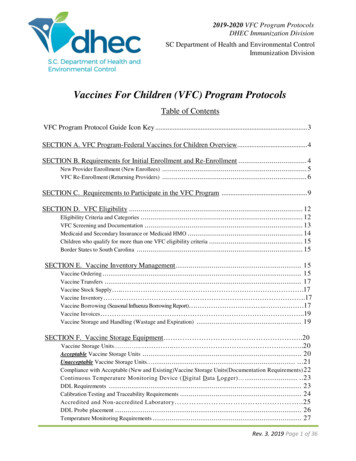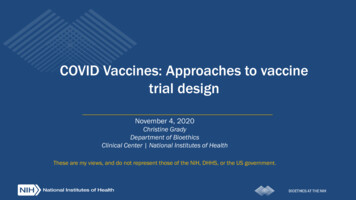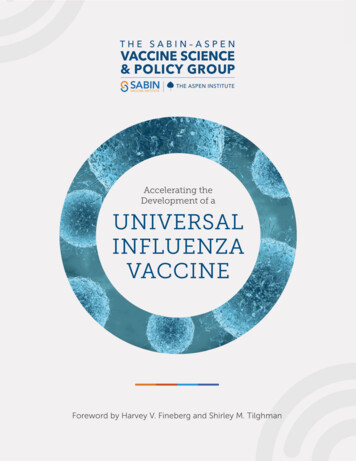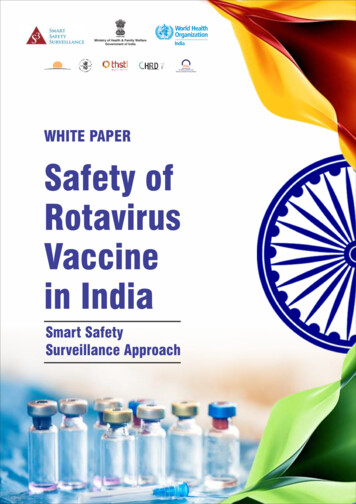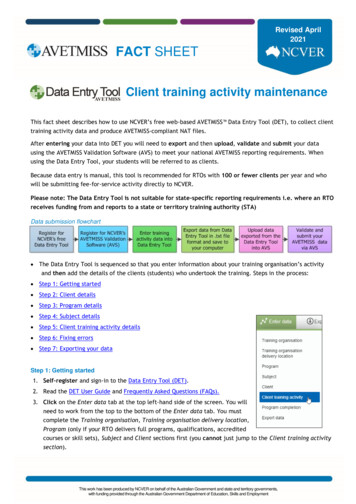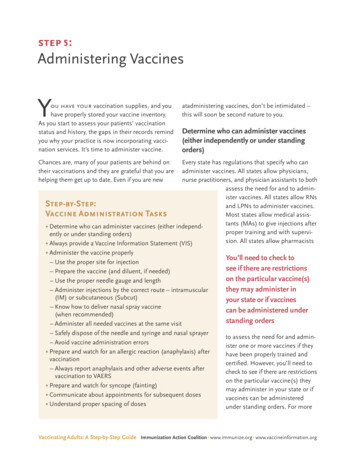
Transcription
step ₅ :Administering VaccinesYou have your vaccination supplies, and youhave properly stored your vaccine inventory.As you start to assess your patients’ vaccinationstatus and history, the gaps in their records remindyou why your practice is now incorporating vaccination services. It’s time to administer vaccine.atadministering vaccines, don’t be intimidated –this will soon be second nature to you.Determine who can administer vaccines(either independently or under standingorders)Every state has regulations that specify who canadminister vaccines. All states allow physicians,nurse practitioners, and physician assistants to bothassess the need for and to administer vaccines. All states allow RNsStep-by-Step:and LPNs to administer vaccines.Vaccine Administration TasksMost states allow medical assistants (MAs) to give injections after Determine who can administer vaccines (either independproper training and with superviently or under standing orders)sion. All states allow pharmacists Always provide a Vaccine Information Statement (VIS)Chances are, many of your patients are behind ontheir vaccinations and they are grateful that you arehelping them get up to date. Even if you are new Administer the vaccine properly– Use the proper site for injection– Prepare the vaccine (and diluent, if needed)– Use the proper needle gauge and length– Administer injections by the correct route – intramuscular(IM) or subcutaneous (Subcut)– Know how to deliver nasal spray vaccine(when recommended)– Administer all needed vaccines at the same visit– Safely dispose of the needle and syringe and nasal sprayer– Avoid vaccine administration errors Prepare and watch for an allergic reaction (anaphylaxis) aftervaccination– Always report anaphylaxis and other adverse events aftervaccination to VAERS Prepare and watch for syncope (fainting) Communicate about appointments for subsequent doses Understand proper spacing of dosesYou’ll need to check tosee if there are restrictionson the particular vaccine(s)they may administer inyour state or if vaccinescan be administered understanding ordersto assess the need for and administer one or more vaccines if theyhave been properly trained andcertified. However, you’ll need tocheck to see if there are restrictionson the particular vaccine(s) theymay administer in your state or ifvaccines can be administeredunder standing orders. For moreVaccinating Adults: A Step-by-Step Guide Immunization Action Coalition www.immunize.org www.vaccineinformation.org
68 step 5:Administering Vaccinesinformation about standing orders and who is eligible to provide vaccination services using them,which might include RNs, pharmacists, and MAs,see the Immunization Action Coalition’s (IAC) UsingStanding Orders for Administering Vaccines: WhatYou Should Know at www.immunize.org/catg.d/p3066.pdf. You also should check with your statemedical licensing board for the regulations in yourpractice location. Another great resource is IAC’s10 Steps to Implementing Standing Orders forImmunization in Your Practice Setting available atwww.immunize.org/catg.d/p3067.pdf.Regardless of the local regulations, proper vaccineadministration technique is a skill that requirespractice. If you have not administered injectable ornasal spray vaccines recently, you should refreshyour skills. In addition to watching a vaccine administration video (one example is discussed later inthis chapter), you should consider contacting yourlocal health department. Staff there may be ableto provide hands-on training with this importantprocedure, or they can head you in the right directionfor guidance.Always provide a Vaccine InformationStatement (VIS)Since 1994, healthcare providers who administerVISs are available for all vaccines any vaccinecovered bylicensed in the United States, and the Nationalmany are available in multipleChildhoodlanguages on the IAC website atVaccineInjury Actwww.immunize.org/vis.VACCINE INFORMATION STATEMENT,QÀXHQ]D )OX 9DFFLQH ,QDFWLYDWHG RU 5HFRPELQDQW What you need to know 1 :K\ JHW YDFFLQDWHG",QÀXHQ]D ³ÀX LV D FRQWDJLRXV GLVHDVH WKDW VSUHDGV around the United States every year, usually betweenOctober and May.)OX LV FDXVHG E\ LQÀXHQ]D YLUXVHV DQG LV VSUHDG PDLQO\ by coughing, sneezing, and close contact. Q\RQH FDQ JHW ÀX )OX VWULNHV VXGGHQO\ DQG FDQ ODVW several days. Symptoms vary by age, but can include: fever/chills sore throat muscle aches fatigue cough headache runny or stuffy noseFlu can also lead to pneumonia and blood infections, andcause diarrhea and seizures in children. If you have aPHGLFDO FRQGLWLRQ VXFK DV KHDUW RU OXQJ GLVHDVH ÀX FDQ PDNH LW ZRUVH Flu is more dangerous for some people. Infants andyoung children, people 65 years of age and older,pregnant women, and people with certain healthFRQGLWLRQV RU D ZHDNHQHG LPPXQH V\VWHP DUH DW JUHDWHVW ULVN Each year thousands of people in the United States dieIURP ÀX, and many more are hospitalized.Flu vaccine can: NHHS \RX IURP JHWWLQJ ÀX PDNH ÀX OHVV VHYHUH LI \RX GR JHW LW DQG NHHS \RX IURP VSUHDGLQJ ÀX WR \RXU IDPLO\ DQG other people. Many Vaccine Information Statements areavailable in Spanish and other languages.See www.immunize.org/visHojas de información sobre vacunas estándisponibles en español y en muchos otrosidiomas. Visite www.immunize.org/vis7KHUH LV QR OLYH ÀX YLUXV LQ ÀX VKRWV They cannot causeWKH ÀX 7KHUH DUH PDQ\ ÀX YLUXVHV DQG WKH\ DUH DOZD\V FKDQJLQJ (DFK \HDU D QHZ ÀX YDFFLQH LV PDGH WR SURWHFW DJDLQVW WKUHH RU IRXU YLUXVHV WKDW DUH OLNHO\ WR FDXVH GLVHDVH LQ WKH XSFRPLQJ ÀX VHDVRQ %XW HYHQ ZKHQ WKH vaccine doesn’t exactly match these viruses, it may stillprovide some protection.Flu vaccine cannot prevent: ÀX WKDW LV FDXVHG E\ D YLUXV QRW FRYHUHG E\ WKH YDFFLQH or LOOQHVVHV WKDW ORRN OLNH ÀX EXW DUH QRW ,W WDNHV DERXW ZHHNV IRU SURWHFWLRQ WR GHYHORS DIWHU YDFFLQDWLRQ DQG SURWHFWLRQ ODVWV WKURXJK WKH ÀX VHDVRQ RPH SHRSOH VKRXOG QRW JHW 6WKLV YDFFLQHTell the person who is giving you the vaccine: ,I \RX KDYH DQ\ VHYHUH OLIH WKUHDWHQLQJ DOOHUJLHV If you ever had a life-threatening allergic reactionDIWHU D GRVH RI ÀX YDFFLQH RU KDYH D VHYHUH DOOHUJ\ WR any part of this vaccine, you may be advised not toJHW YDFFLQDWHG 0RVW EXW QRW DOO W\SHV RI ÀX YDFFLQH contain a small amount of egg protein. If you ever had Guillain-Barré Syndrome (alsoFDOOHG *%6 6RPH SHRSOH ZLWK D KLVWRU\ RI *%6 VKRXOG QRW JHW WKLV vaccine. This should be discussed with your doctor. ,I \RX DUH QRW IHHOLQJ ZHOO ,W LV XVXDOO\ RND\ WR JHW ÀX YDFFLQH ZKHQ \RX KDYH D PLOG LOOQHVV EXW \RX PLJKW EH DVNHG WR FRPH EDFN when you feel better., QDFWLYDWHG DQG UHFRPELQDQW ÀX YDFFLQHV GRVH RI ÀX YDFFLQH LV UHFRPPHQGHG HYHU\ ÀX VHDVRQ Children 6 months through 8 years of age may need twoGRVHV GXULQJ WKH VDPH ÀX VHDVRQ (YHU\RQH HOVH QHHGV RQO\ RQH GRVH HDFK ÀX VHDVRQ 6RPH LQDFWLYDWHG ÀX YDFFLQHV FRQWDLQ D YHU\ VPDOO amount of a mercury-based preservative calledthimerosal. Studies have not shown thimerosal inYDFFLQHV WR EH KDUPIXO EXW ÀX YDFFLQHV WKDW GR QRW contain thimerosal are available.(Section 2125 of the Public Health Service Act [42U.S.C. §300aa-26]) are required to provide a copy ofthe relevant federal Vaccine Information Statement(VIS) before administering most vaccines to aperson of any age, including adults. VISs are available for all vaccines licensed in the United States,and many are available in multiple languages onthe IAC website at www.immunize.org/vis. A listingof the most current versions for each VIS also maybe found on this website. Patients must be offereda copy (which can be an electronic copy) of theVIS to take home with them, though the recipientmay decline. (You can learn more about this federalrequirement in Step 6 – Documentation and RelatedIssues.) You probably will want to give patients evenmore information aboutRemember – if you don’tthe disease that the vacadminister the vaccinecine prevents, as wellas answer any questions properly, you mightthey may have.as well not give it at all.Administer the vaccine properlyRemember – if you don’t administer the vaccineproperly, you might as well not give it at all. You’vegone to a lot of trouble to keep your vaccines“viable,” and your patients need this protection.What a waste it would be for the vaccine not to beadministered properly!One common mistake is that too short a needle isused – a subcutaneous “Subcut” needle rather thanan intramuscular “IM” needle. When this happens,the vaccine can be injected into fat instead ofinto muscle. You may hear that some vaccines willU.S. Department ofHealth and Human ServicesCenters for DiseaseControl and PreventionVaccinating Adults: A Step-by-Step Guide Immunization Action Coalition www.immunize.org www.vaccineinformation.org
step 5:usually still work if given via the wrong route andwill merely cause greater temporary local discomfort. While that may be true for some, for others,such as hepatitis B, HPV, influenza, and rabiesvaccines, the correct route is essential to obtainingan adequate immune response.cdcWe will not be discussing oral vaccines in the Guide.The only oral vaccine currently licensed for routineuse in the U.S. is rotavirus, which is only administered to infants. In addition, one influenza vaccine(Fluzone Intradermal, Sanofi Pasteur) is specificallylicensed for intradermal (into theskin) injection. Thisvaccine is administered with a speciallydesigned microneedle and syringeinto the deltoid area. If you stock this type of influenza vaccine (it currently is approved only for people18 through 64 years of age), you should thoroughlyacquaint yourself with how to use the injectionsystem by reading the instructions in the productinformation. No other U.S. vaccine should ever beadministered by the intradermal route. (Note thata tuberculin skin test, or PPD, which is administeredintradermally, is a diagnostic test – NOT a vaccine.)IAC’s Administering Vaccinesto Adults: Dose, Route, Site,and Needle Size, available atwww.immunize.org/catg.d/p3084.pdf, provides a conciseguide to help you ensure youare administering vaccinesproperly. In addition, after youwww.immunize.org/read this chapter, watch thecatg.d/p3084.pdfCalifornia Department of Public Health’s DVD titled Immunization Techniques: BestPractices with Infants, Children, and Adults. The DVD isAdministering Vaccines to Adults:Dose, Route, Site, and Needle Sizevaccinedose routeIntramuscular (IM) injectionHepatitis A (HepA)Ĵ \UV P/ĵ \UV P/Hepatitis B (HepB)Ĵ \UV P/ĵ \UV P/IMHepA-HepB (Twinrix)ĵ \UV P/IM0.5 mLIM,QƬXHQ]D OLYH DWWHQXDWHG (LAIV)0.2 mL (0.1 mL intoeach nostril)NAS (Intranasal spray),QƬXHQ]D LQDFWLYDWHG (IIV) andrecombinant (RIV)0.5 mLIM,QƬXHQ]D (IIV) Fluzone Intradermal,for ages 18 through 64 years0.1 mLID (Intradermal)Measles, Mumps, Rubella (MMR)0.5 mLMeningococcal conjugate (MenACWY)0.5 mLHuman papillomavirus (HPV)IM90 angleskinsubcutaneous tissuemuscleSubcutaneous (SubCut) injection45 anglesubcutaneous tissueIM0.5 mLSubCut90 angle0.5 mLIM0.5 mLIM or SubCutTetanus, Diphtheria (Td) with Pertussis(Tdap)0.5 mLIMVaricella (VAR)0.5 mLSubCut0.65 mLSubCutSubcutaneous (SubCut) injection – Use a 23–25 gauge, 5/8" needle.Inject in fatty tissue over triceps.Administerin areaof deltoidIntranasal (NAS) administration of Flumist (LAIV) vaccineIntramuscular (IM) injection – Use a 22–25 gauge needle. Inject indeltoid muscle of arm. Choose the needle length as indicated below:Gender/WeightFemale or male 130–152 lbsFemale 153–200 lbsMale 153–260 lbsFemale 200 lbsMale 260 lbsavailable for a nominal chargeat www.immunize.org/dvd,or the video may be streamedat www.youtube.com/watch?v WsZ6NEijlfI. Unlike thisGuide, which is limited to adultimmunization issues, the videoalso covers infant and child injections. Watchingthis video will give you an idea of the differences,as well as the similarities, involved – and will remindyou that it really is simpler to vaccinate adults.Use the proper site for injectionFor adult vaccinations, all you need to give an injection is the patient’s deltoid muscle in the upperarm, although the muscle in the thigh can be usedif necessary. (For infant vaccinations, the thigh isgenerally used as an injection site.) Except for theintradermal influenza vaccine mentioned above,vaccine injections are either intramuscular (IM) orsubcutaneous (Subcut). Intramuscular (IM) – If you are giving an intramuscular injection, you will inject into the deltoidmuscle below the shoulder on the upper arm,or into the thigh muscle. Subcutaneous (Subcut) – If you are giving asubcutaneous injection, you will inject into thefatty tissue (under the skin and overlying themuscle) on the back of the upper arm.Intradermal (ID) administrationof Fluzone ID vaccinePneumococcal conjugate (PCV13)Female or male less than 130 lbswww.immunize.org/dvdIMPneumococcal polysaccharide (PPSV)Zoster (HZV)69muscleIM0.5 mL0.5 mLMeningococcal polysaccharide (MPSV)Injection SiteandNeedle SizeskinSubCutMeningococcal protein (MenB)Meningococcal serogroup B (MenB)Administering VaccinesNeedle Length5/8"*–1"1"1–11/2"11/2"* A5/8" needle may beused for patients weighing less than 130 lbs( 60 kg) for IM injectionin the deltoid muscleonly if the subcutaneoustissue is not bunchedand the injection is madeat a 90-degree angle.Additional information about these techniques isavailable later in this chapter.note: Always refer to the package insert includedwith each biologic for complete vaccine administrationinformation. CDC’s Advisory Committee on Immunization Practices (ACIP) recommendations for theparticular vaccine should be reviewed as well. Accessthe ACIP recommendations at www.immunize.org/acip.Technical content reviewed by the Centers for Disease Control and PreventionSaint Paul, Minnesota 651-647-9009 www.immunize.org p3084.pdf Item #P3084 (9/15)Prepare the vaccine (and diluent, if needed)Information about appropriate preparation for eachvaccine is available in the package insert. (IAC maintains a web page which links to all package inserts atwww.immunize.org/packageinserts.) However, thegeneral steps involved in preparing different vaccine formulations are shown in the box on page 71.Vaccinating Adults: A Step-by-Step Guide Immunization Action Coalition www.immunize.org www.vaccineinformation.org
70 step 5:Administering VaccinesVaccine vials are labeled with the number of dosesthey contain. If you are using vaccine from a multidose vial, withdraw just the amount required forthe dose into the syringe. Single-dose vials are widelyused, and manufacturer pre-filled syringes alsoare available.Most vaccines administered to adults in the U.S. areprovided as a liquid, ready to inject. However, severaladult vaccines (MMR, variUse only the diluent cella, Menveo [MenACWY],that was shipped to Bexsero [MenB] and zoster)you with the vaccine require reconstitution of powdered vaccine with a liquidyou are preparing.diluent that is supplied bythe manufacturer in a separate vial. The diluent iseither saline or sterile water, except for the Menveobrand of MenACWY, in which the diluent containsthree of the antigenic components of the vaccine.Do not substitute saline, sterile water, or any otherliquid from your clinic’s general supplies if youmisplace a diluent! Use only the diluent that wasshipped to you with the vaccine you are preparing.Any dose of vaccine reconstituted with the wrongdiluent must be repeated. Additional information ondiluents is available in Vaccines with Diluents: Howto Use Them, found at www.immunize.org/catg.d/p3040.pdf.Different vaccines should never be combined in asingle syringe, except when specifically approvedby the FDA and packaged for that specific purpose.Most combination vacVaccine shouldcines (e.g., MMR ornever be transferredTdap) will be combinedby the manufacturer.from one syringe toVaccine should never beanother.transferred from onesyringe to another, and partial doses from separatevials should not be combined into a single syringe.Both of these practices increase the risk ofcontamination.If you are preparing more than one vaccine for apatient, be sure to label which syringe containswhich vaccine. A simple way to label the vaccinesis to use a silverware tray with permanently labeledseparate “slots” for Tdap, influenza, hepatitis B,and other vaccine syringes. Or, keep on hand smallsticky labels with vaccine names (these can bepreprinted), and attach the appropriate vaccine labelto the syringe containing that vaccine.As discussed in Step 3: Vaccine Storage and Handling,you should not reconstitute or fill vaccine syringesin advance. Prepare and draw up vaccine onlywhen you are ready to administer it.Once you know ifan injection will begiven IM or Subcut,you can determinewhat length andgauge needle youneed.cdcUse the proper needle gauge and lengthIt is critical for vaccine to be deposited into theproper tissue. An intramuscular injection usuallyrequires a longer needle than a subcutaneous(Subcut) injection. Once you know if an injectionwill be given IM or Subcut, you can determinewhat length and gauge needle you need.For almost all IM injections with most adults, youwill need a 1"–1½", 22–25 gauge needle. If apatient is particularly large (i.e., women weighing200 pounds or more, men weighing 260 poundsor more), you should use a 1½" needle. For Subcutinjections, you will need a 5 8", 23–25 gauge needlefor everyone.Vaccinating Adults: A Step-by-Step Guide Immunization Action Coalition www.immunize.org www.vaccineinformation.org
step 5:Administering Vaccines71Steps in Preparing Different Vaccine Formulations(adapted from the California Immunization Program’s EZIZ resources)Before You Start Preparing ANY Type of Vaccine Wash your hands. Gather alcohol pads, the appropriate needle,and, as needed, a syringe. Get the vial or syringe of vaccine. (Alwaysdouble check the vial label to make sure youhave the vaccine you want to administer. Vac-cine vials can look alike or have similarsounding names.) Check the vaccine against the clinician’s written order or standing order. Check that today’s date is sooner than thevaccine’s expiration date.Drawing Up LIQUID VACCINEPreparing RECONSTITUTED VACCINESingle-dose VialMixing the Vaccine Remove plastic cap. Shake vial. Cleanse stopper with alcohol pad and let it dry. Assemble needle and syringe. Uncap needle. Hold vial steady on counter. Insert needle straight into center of vial stopper. Invert (turn upside-down) vial and pull needle Remove plastic caps. Cleanse stoppers with alcohol pad and let dry.* Assemble needle and syringe. Hold diluent vial steady on counter. Insert needle straight into center of vial stopper. Invert (turn upside-down) vial and pull needleback so the tip is in the liquid. Pull back on plunger and draw up entire contents of vial. Withdraw needle. Tap syringe and push out air. Recap the clean needle.Pre-filled Syringeback so the tip is in the liquid. Draw up all diluent into syringe and then withdraw needle. Hold vaccine vial steady on counter. Insert needle into center of stopper. Inject diluent. Holding vial and syringe together, shake to mix.* Be sure MMR, varicella, MMRV, and Zostavax vial stoppersare thoroughly dry. Alcohol may damage these live vaccines. Shake syringe thoroughly. Remove syringe tip cover. Attach needle to syringe.Vaccinating Adults: A Step-by-Step Guide Immunization Action Coalition www.immunize.org www.vaccineinformation.org
72 step 5:Administering VaccinesAdminister injections by the correct route –intramuscular (IM) or subcutaneous (Subcut)Intramuscular (IM) injectionsIntramuscular injections are administered into thedeltoid muscle, which is a large triangular musclethat wraps over the shoulder into the upper arm.For vaccine injections, use the center part of thedeltoid, usually about two finger-breadths below theacromion process (bony prominence above thedeltoid) and above armpit-level in the upper arm.It seems like a largeProper deltoid injection is “target,” but propercritical in order not to hitdeltoid injectionis critical in order notthe underlying bone,blood vessels, and nerves. to hit the underlyingbone, shoulder capsule, blood vessels, and nerves. If you have nevergiven an IM injection or haven’t given one for a longtime, you should refresh your skills by watchinga video and having hands-on, supervised practicebefore you attempt it.Grasp the muscle between the thumb and fingersof your non-injecting hand. The needle should thenbe inserted perpendicular (that is, at a 90-degreeangle) to the skin into the thickest part of the muscle. Insertion should be quick yet firm and steady.cdcThere are several reasons for differentiatingbetween IM and Subcut injections. Subcut dosesare absorbed more slowly than IM doses. If yougive an IM vaccine subcutaneously by mistake, theantibody “titers” (the level of antibodies in a bloodsample) that result may be lower than they otherwise would be, and the injection also may be morepainful. Some vaccines that contain an “adjuvant”(an ingredient that enhances the immune responseto the antigens) must be given IM to avoid thelocal irritation, inflammation, or other reactions thatcan occur if they are administered subcutaneously.For our purposes, the important thing to rememberis that the type of injection matters. It is not arbitrary.IM in deltoid: 90-degree angle; 1" or longer needleAfter the needle is inserted (to the hub of the needle),depress the plunger steadily, and then withdraw theneedle quickly.Vaccines thatare given viaintramuscular(IM) injection Hepatitis A Hepatitis B Human papillomavirus (HPV) Influenza, inactivated(exception: intradermalformulation) Meningococcal conjugate(Men ACWY) Meningococcal serogroup B(MenB) Pneumococcal conjugate (PCV) Pneumococcal polysaccharide(PPSV) (also can be givenSubcut) Polio (also can be given Subcut) Shingrix (zoster, shingles) Tdap/TdSubcutaneous (Subcut) injectionsTo administer a vaccine with a subcutaneous injection, you want to “pinch up” the subcutaneous(fatty) tissue on the back of the upper arm with yournon-injecting hand and inject the needle at a45-degree angle into the fat – a much narrower anglethan that for an IM injection. Insert the needle allthe way to the hub of the needle.Vaccinating Adults: A Step-by-Step Guide Immunization Action Coalition www.immunize.org www.vaccineinformation.org
step 5:Administering Vaccines73You should always have patients sit down for bothIM and Subcut injections. Occasionally, a patientmay feel faint at the sight of a needle or during aninjection; if the patient is sitting instead of standing, this will lessen the chance of the patient falling.Subcut inouter arm:45-degreeangle;5 8" needleKnow how to deliver nasal spray vaccine(when recommended*)cdcVaccines thatare given viasubcutaneous(Subcut)injection MMR Pneumococcal polysaccharide(also can be given IM) Polio (also can be given IM) Varicella (chickenpox) Zostavax (zoster, shingles)For both IM and Subcut injections, expose theentire area of the upper arm so that the sleeve doesnot obstruct the injection site. Wipe the injectionarea with an alcohol swab to clean away skin dirt(this prevents the needle from pushing skin dirtinto the tissue), using an outward spiraling motionin a circle from the center to a two- or three-inchdiameter.Although you may wear glovesif you choose to, they are notrequired for giving injections.Although you may wear gloves if you choose to, theyare not required for giving injections. If you chooseto wear gloves, they must be changed betweenevery patient. Your hands should always be cleanedwith soap and water or an alcohol-based waterlessantiseptic before vaccine preparation, betweenpatients, and any other time hands become soiled.Live attenuated influenza vaccine (LAIV – FluMist,MedImmune), licensed for adults through age 49years, is given by the intranasal route using aspecial sprayer. Half of the vaccine is sprayed intoeach nostril. A plastic clip on the plunger dividesthe dose into two equal parts. The patient shouldbe seated in an upright position. Instruct thepatient to breathe normally. Gently place a handbehind the patient's head. The tip of the nasalsprayer should be inserted slightly into the nasalpassage. Half of the contents of the sprayer (0.1 mL)is sprayed into the first nostril. The dose-dividerclip is then removed and the procedure is repeatedin the other nostril. The dose does not need to berepeated if the patient coughs or sneezes. Consultthe package insert for additional information onthe nasal administration of LAIV.* note: As of this writing, use of LAIV is not recommendedby ACIP for the 2017–2018 influenza season. Follow ACIPguidance for each season’s recommendations.Administer all needed vaccines at the same visitThe Recommended Adult Immunization Schedule,found at lt-combined-schedule.pdf, iscomplicated by a variety of factors. Most vaccinesrequire more than one dose to create the properimmune response. Also, if you are giving differentlive attenuated vaccines, they either must be administered on the same day or be separately administered at least 4 weeks apart, in order to reduceimmune response interference. For adults, the mostVaccinating Adults: A Step-by-Step Guide Immunization Action Coalition www.immunize.org www.vaccineinformation.org
74 step 5:Administering Vaccinescommon combination of live vaccines would involveMMR, varicella, and/or LAIV, in which case youneed to take extra care in “dose spacing.” It’s alwaysbest to give live vaccines at the same visit. If this isnot possible for some reason, space them at least4 weeks apart.Simultaneous administrationis encouraged because itis convenient and efficient forboth patient and provider.Administration ofdoses of multiplevaccines at a singlevisit does notresult in decreasedantibody responses or increased reactions. In fact,simultaneous administration is encouraged becauseit is convenient and efficient for both patient andprovider.Consider using “site maps” tostandardize specific vaccinationlocations (limb choice) on yourpatients. Use of a site map (suchas the California ImmunizationProgram’s Immunization SiteMap found at www.eziz.org/assets/docs/IMM-718A.pdf) cansimplifythe process of adminiswww.eziz.org/assets/docs/IMMtering vaccines by reducing on718A.pdfthe-spot decision-making aboutwhich limb to use for a particular vaccine. It alsocan make identification of the cause of a localizedreaction easier because you will know exactly whereyou injected each vaccine. A site map creates consistency within your clinic practice and assists youin documenting the site of administration alongwith the vaccine and dose in your patient’s chart.If you are giving two injections, the patient mayprefer one in each arm. If you are giving three ormore injections, you will need to give the patient atleast two in the same arm. The distance betweenIM injection sites in the same extremity should beat least 1 inch apart, if possible. When administeringTdap or Td, you may want to give it in an arm byitself because it is known to cause more sorenessand swelling than other vaccines. Two differentSubcut injections can be given in opposite arms,unless the patient wants both in the same one.In that case, the Subcut injections also should beadministered at least 1 inch from each other.Safely dispose of the needle and syringeand nasal sprayerAfter you have administered a vaccine by injection,remove the needle from the patient in a smoothmotion at the same angle at which you inserted it.Do not recap the needleafter use. Immediatelydiscard the used needle(still attached to thesyringe) into a sharpscontainer.cdcDo not recap the needle after use. Immediately discard the used needle (still attached to the syringe)into a sharps container, keeping your eyes on theneedle continuously until it is placed into the container. This is part of Occupational Safety andHealth Administration safety protocol. Needlestickinjuries are serious, and they must be prevented.Apply pressure to the injection site with a cottonball or gauze, and put an adhesive bandage over itif blood is present.Nasal sprayers also should be disposed in a sharpscontainer.Consult with your clinic’s waste disposal serviceregarding the frequency of pick-up and replacementof sharps containers.Vaccinating Adults: A Step-by-Step Guide Immunization Action Coalition www.immunize.org www.vaccineinformation.org
step 5:Vaccine administrationerrors are not acceptable,and procedures shouldbe in place in your clinicto prevent them.wrong!Avoid vaccine administration errorsA vaccine administration error is a situation wherea patient receives the wrong vaccine, receives thevaccine by an incorrect route, receives the wrongdosage, or receives a vaccine that is expired or reconstituted with the wrong diluent. Vaccine administration errors are not acceptable, and proceduresshould be in place in your clinic to prevent them.The “Rights of Medication Administration” outlined in the Centers for Disease Control and Prevention (CDC) “Pink Book” at www.cdc.gov/vaccines/pubs/pinkbook/vac-admin.html should be appliedto each encounter when vaccines are administered.These rights include: the right patient; the right vaccine and diluent (when applicable); the right time;* the right dosage; the right route, needle length, and technique; the right site; and the right documentation.* Includes administering at the correct age, the appropriateinterval, and before vaccine or diluent expiresAdditional information may be found in an articlewritten by IAC’s Deborah L. Wexler, MD, Know the“7 Rights” of Vaccine Administration (available sp).Administering Vaccines75Stop Vaccine Administration ErrorsBefore They Happen! When suitable for your situation, consult staff inchoosing the
p3084 .pdf, provides a concise guide to help you ensure you are administering vaccines properly. In addition, Technical content reviewed by the Centers for Disease Control and Preventionafter you read this chapter, watch the California Department of Pub - lic Health's DVD titled Immunization Techniques: Best Practices with Infants, Children .






